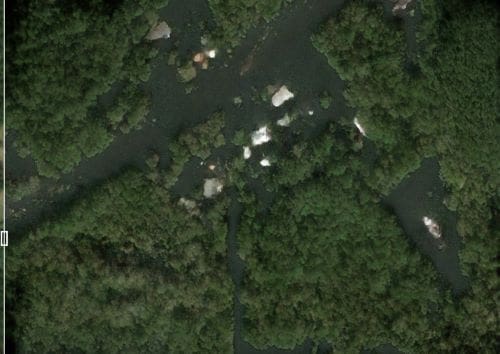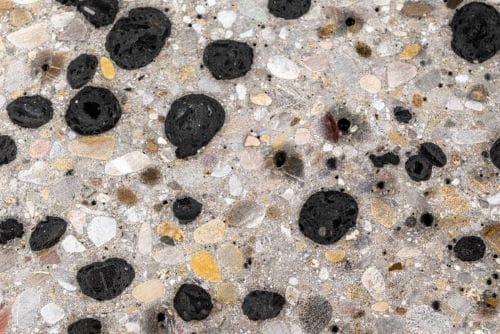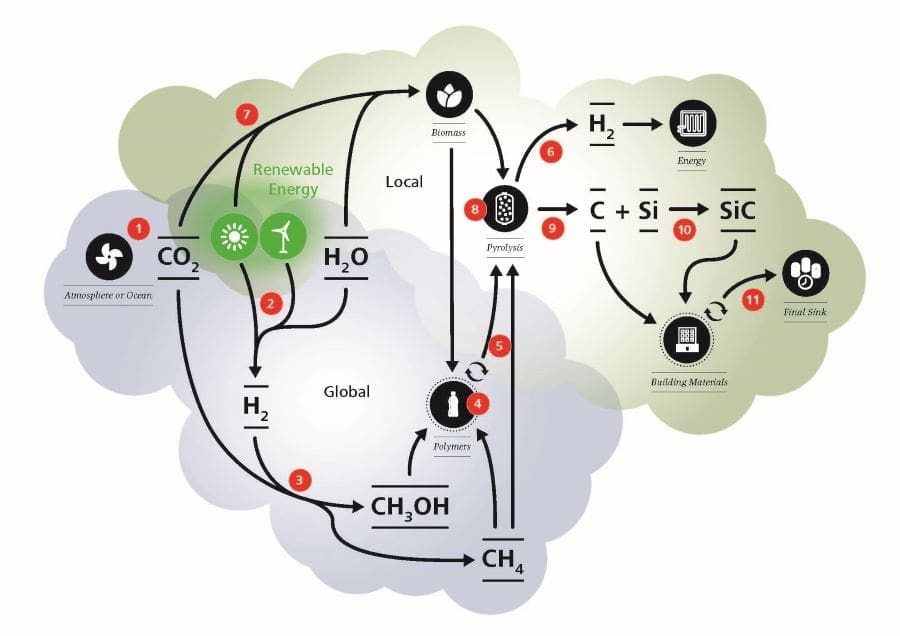Explore the latest insights from top science journals in the Muser Press daily roundup, featuring impactful research on climate change challenges.
Table of Contents
Researchers create AI tool capable of generating realistic satellite images of future floods
The project, involving researchers from the University of Granada (UGR), marks a crucial step towards the generation of reliable and realistic visual tools designed to communicate the impacts of climate change.

A new study involving the UGR shows that deep generative vision models can synthesise highly realistic satellite images that can be used to illustrate future climate-related events such as floods, sea-ice retreat, and reforestation.
Natalia Díaz, a UGR researcher at the Andalusian Inter-University Institute for Data Science and Computational Intelligence (DaSCI), participated in the project in collaboration with researchers from centres and foundations in the United States (including MIT), Canada, Germany and the United Kingdom.
To tackle their research problem, the team used a generative adversarial network (pix2pixHD) to create synthetic satellite images of future flooding, as well as the effects of positive actions such as reforestation. Although the model is capable of generating realistic images, it tends to ‘hallucinate’ floods in the wrong areas.
Their proposed solution to this problem combines deep learning with segmentation maps generated by physics-based flood models. This improved approach outperforms not only the pure deep learning model, but also manual solutions, by significantly reducing prediction errors and improving the reliability of the images.
The research team evaluated the generalisability of their method using multiple remote sensing datasets and climate-related events, including reforestation and melting Arctic sea ice. In addition, they made their code, new metrics, and an extensive dataset available to the scientific community, including more than 30,000 labelled HD image triplets for segmentation-guided image-to-image translation, which is equivalent to 5.5 million images at 128×128 pixels.
This project marks a crucial step towards the creation of reliable and realistic visual tools for communicating the impacts of climate change, establishing further grounds for greater collaboration between the fields of physics-based modelling and deep learning.
The Andalusian Inter-University Institute for Data Science and Computational Intelligence (DaSCI) is a collaborative organisation that is managed jointly by the universities of Granada, Jaén and Córdoba. Its mission is to conduct advanced research and training in the field of artificial intelligence, with a particular focus on data science and computational intelligence.
The Institute brings together preeminent researchers working on joint projects and promotes the development and application of innovative technologies in diverse sectors. With a view to becoming a leading organisation in its field, the DaSCI fosters the transfer of scientific knowledge to the socio-economic environment, thus contributing to technological progress and the digitisation of industry.
Journal Reference:
B. Lütjens et al. ‘Generating Physically-Consistent Satellite Imagery for Climate Visualizations’, IEEE Transactions on Geoscience and Remote Sensing 62, pp. 1-11, 4213311 (2024). DOI: 10.1109/TGRS.2024.3493763
Article Source:
Press Release/Material by University of Granada
How to recycle CO2 from flue gases
Unlike often under laboratory conditions, CO2 makes up only a small proportion of the gas mixture in flue gases or the atmosphere. In order to extract it under realistic conditions and reuse it as a valuable material, catalysis processes must therefore also work when the CO2 concentration is low.

Preventing competitive reactions
“Our problem is the competitive reactions that take place at the catalyst,” explains Wolfgang Schuhmann. “The fewer CO2 molecules there are to convert, the more likely it is that hydrogen will be produced during catalysis instead of the desired product.”
If you adjust the electrolyte and choose a more alkaline solution to prevent this, you have a different problem: CO2 is converted to carbonate and is no longer available for the desired reactions.
Successful catalytic processes for CO2 reduction have already been described down to a carbon dioxide content of 10 to 20 percent. But what if the content is even lower?
“By using a superactive catalyst based on nickel-copper, we were able to successfully catalyze the reduction down to a CO2 content of five percent,” says Adib Mahbub, the first author of the publication. Below this level, the researchers had to reach into their bag of tricks: By adjusting the electrical potentials and the electrolyte, it was then even possible to carry out the reduction from a gas mixture with just two percent CO2.
“Although this means a loss of energy, clever process control allows us to access sources for the first time that we were previously unable to use for CO2 reduction,” says Schuhmann. “Future generations will have to build on such concepts if they want to extract CO2 from the atmosphere, where the CO2 content is even lower.”
Journal Reference:
M. A. A. Mahbub, D. Das, X. Wang, G. Lu, M. Muhler, W. Schuhmann, ‘Towards the Use of Low-Concentration CO2 Sources by Direct Selective Electrocatalytic Reduction’, Angewandte Chemie International Edition online, e202419775 (2025). DOI: 10.1002/anie.202419775
Article Source:
Press Release/Material by Ruhr-University Bochum (RUB)
The Crop Journal study reveals hidden regulator in foxtail millet farming
Developing crops that adapt to specific climates or seasons is crucial for making food supplies reliable, reducing the environmental footprint of agriculture, and assuring better income for farmers.
Now, researchers have discovered that SiPRR37 gene is capable of boosting the production of foxtail millet, an important crop. Their findings reveal that the SiPRR37 gene regulates millet flowering based on day length, enabling the crop to adapt to diverse climates and achieve higher yields.
In agriculture, flowering time is one of the most crucial factors affecting crop survival and production, especially in millets. Foxtail millet (Setaria italica), a nutritious and resilient millet grown across diverse climatic regions of the world, has been reported to be able to modulate its own flowering time.
Owing to its ability to tolerate drought and barren soils, foxtail millet is increasingly being used as a plant model for studying gene function and crop improvement.

Several studies in the past have attempted to understand the mechanisms underlying heading date in foxtail millet. Understanding the molecular mechanisms and manipulating them can allow scientists to develop millet varieties that are better suited to specific climates or seasons beyond their original cultivation regions.
In a new study published in The Crop Journal, researchers from Chinese Academy of Agricultural Sciences in China discovered that the SiPRR37 gene plays a vital role in adjusting the flowering time based on day length. This allows foxtail millets to thrive across different climates and regions.
“Our study reveals that natural variations in SiPRR37 gene enables millets to adapt its flowering time to specific regional climates,” shares lead author Liwei Wang, an Agricultural Doctor at the academy’s Institute of Crop Sciences. “This not only gives us a deeper understanding of the plant genetics but also provides a tool to optimize millet breeding.”
Notably, the researchers conducted genome-wide association study (GWAS) of 680 millet varieties to identify genetic variants capable of regulating flowering time. The analysis revealed that SiPRR37 gene was responsible for DNA trait locus, termed Hd2, which controls the timing of flowering in foxtail millet.
Their evaluation revealed that a jumping gene — genes that transfer traits across genomes — known as “Tc1-Mariner transposon” was responsible for the variants of SiPRR37. The gene variants were haplotypes (i.e., a set of DNA variations, or polymorphisms, that tend to be inherited together) and differed across geographical locations.
“We identified two major haplotype variants, Hap 1, which is dominant in high-latitude regions, promotes early flowering. In contrast, Hap 2, dominant in low-latitude regions, delays flowering to extend the growing season,” explains Wang. “The impact of SiPRR37 changes on flowering time was then confirmed using CRISPR/Cas9 gene-editing technology. SiPRR37 regulates flowering in a bifunctional manner, which means it delays flowering under long-day conditions and promotes flowering under short-day conditions. This functional switch is dependent on a critical day length of 14.3 hours.”
By editing the SiPRR37, it is possible to create millet variants tailored to specific climates. For instance, early flowering varieties can thrive in high-latitude regions while later-flowering varieties can address challenges like early maturation and low yield in tropical areas.
The study also highlights how genetic engineering can help transform agriculture and help in reducing risks associated with unpredictable weather patterns.
“We plan to explore how SiPRR37 interacts with other flowering-related genes to uncover additional strategies for breeding crops optimized for diverse environments. Our ultimate goal is to provide more reliable food supplies and improve farmers’ livelihood,” says Wang.
Journal Reference:
Liwei Wang, Bao Tian, Qiang He, Guanqing Jia, Bin Liu, Qiong Lu, Hui Zhi, Xianmin Diao, ‘SiPRR37 exerts dual functions in the regulation of photoperiodic flowering and contributes to the ecological adaption of foxtail millet’, The Crop Journal (2024). DOI: 10.1016/j.cj.2024.12.004
Article Source:
Press Release/Material by KeAi Publishing
Concrete as a carbon store
In order to reduce the CO2 concentration in the atmosphere to the target level of 1988 – i.e. to 350 ppm (parts per million) – an estimated 400 billion tons of carbon must be removed from the atmosphere. This is a huge amount, equivalent to around 1,500 billion tons of CO2.
EMPA researchers have now calculated that this excess carbon could be stored in building materials such as concrete by the middle of the next century.
“These calculations are based on the assumption that sufficient renewable energy will be available after 2050 to remove CO2 from the atmosphere – a very energy-intensive endeavor. This assumption allows us to use different scenarios to analyze how realistic and efficient the concept of our Mining the Atmosphere initiative is,” says Pietro Lura, Head of Empa’s Concrete and Asphalt laboratory.
The large-scale research initiative has set itself the goal of not only binding excess CO2, but also using it as a valuable raw material.
Building materials are crucial
Surplus renewable energy is used to convert CO2 into methane or methanol, which in turn are further processed into polymers, hydrogen or solid carbon.

“Even if sufficient renewable energy is available, the central question remains as to how these huge quantities of carbon can be stored in the long term. Concrete seems predestined for this, as it can absorb enormous quantities,” explains Lura. The researchers therefore compared the mass of materials used worldwide, such as concrete, asphalt and plastics, with the amount of carbon that needs to be removed from the atmosphere – including emissions that are difficult to avoid.
“The mass of building materials required worldwide far exceeds the excess carbon in the atmosphere. However, it remains a challenge how quickly and efficiently carbon can be introduced into these materials without deteriorating their properties,” concludes Lura.
Compared to other CO2 reduction measures such as underground storage, the Mining the Atmosphere approach offers several advantages: It ensures long-term stability as well as a high storage density of carbon and enables decentralized implementation. At the same time, conventional CO2-emitting building materials can be replaced.
“Carbon must be incorporated into stable materials, as direct storage can be dangerous – for example, due to the risk of fire. Ideally, these carbon-enriched building materials are used over several recycling cycles before they are finally disposed of safely,” says Lura.
According to the EMPA researcher, this concept should not only contribute to the reduction of CO2, but also enable a carbon-binding economy that offers both ecological and economic benefits.
“Carbon from the atmosphere can be used, for example, to produce polymers, bitumen for asphalt or ceramic materials such as silicon carbide. In addition, other high-value materials such as carbon fibers, carbon nanotubes and graphene could make the whole process economically viable – with concrete clearly accounting for the largest share of carbon storage.”
Hard carbon rocks as an accelerator
So how long would it take to remove all the excess CO2 from the atmosphere? In an optimal scenario, building materials such as concrete could bind up to ten gigatons of carbon per year. However, this potential would only be fully exploited from 2050, when sufficient renewable energy is available after the energy transition.
In addition to the surplus 400 gigatons of carbon, at least an additional 80 gigatons would have to be removed from emissions that are difficult to avoid by 2100. According to the various scenarios, the surplus CO2 could be completely absorbed in building materials within 50 to 150 years – which would bring the CO2 level back to the target level of 350 ppm.
The key to the most optimistic scenarios lies in the production of silicon carbide, which can be used as a filler in building materials. “Silicon carbide offers enormous advantages, as it binds carbon practically forever and has excellent mechanical properties. However, its production is extremely energy-intensive and represents one of the greatest challenges, both in terms of cost-effectiveness and sustainable implementation,” says Pietro Lura.
It would take more than 200 years to eliminate the entire anthropogenic carbon surplus with carbon in the form of porous aggregate alone. A combination of porous carbon and silicon carbide is therefore a viable solution. This would allow large quantities of carbon to be stored in concrete, which would also be more durable and stable than conventional concrete.
“Nevertheless, the aim should be to remove as much CO2 as possible from the atmosphere each year in order to achieve 350 ppm CO2 in a realistic timeframe together with other measures. At the same time, it is crucial to continuously minimize our emissions so that the recovery process is not in vain,” says the EMPA researcher.
Mining the Atmosphere
To achieve climate targets and prevent irreversible changes to the climate system, it is not enough to reduce greenhouse gas emissions. It is also necessary to actively remove excess CO2 from the atmosphere. This is precisely where Empa’s large-scale research initiative, Mining the Atmosphere, comes in. The aim is to create a completely new global economic model and an associated industrial sector that uses CO2 as the raw material of the future. CO2 is first converted into basic chemicals such as methane or methanol.
These are then further processed to replace conventional building materials and petrochemical products. At the end of their life cycle, these carbon-rich materials will be stored in special landfills to permanently bind the carbon. Thanks to the synthetic methane, energy can also be transported from sunny locations to countries with an energy gap in winter.
However, according to the Empa researchers, implementation requires further progress in materials research and process development, particularly in order to make optimum use of decentrally generated and fluctuating renewable energies. In addition, a focus on new business models, economic incentives and suitable regulatory frameworks is necessary to make a carbon-neutral society a reality.

Journal Reference:
P Lura, I Lunati, H Desing, M Heuberger, C Bach, P Richner, ‘Mining the atmosphere: A concrete solution to global warming’, Resources, Conservation & Recycling 212, 107968 (2025); DOI: 10.1016/j.resconrec.2024.107968
Article Source:
Press Release/Material by Swiss Federal Laboratories for Materials Science and Technology (EMPA)
Featured image credit: Gerd Altmann | Pixabay




